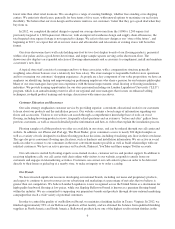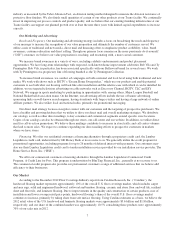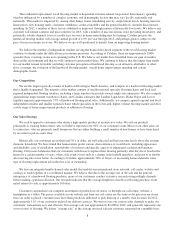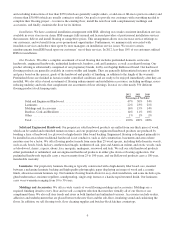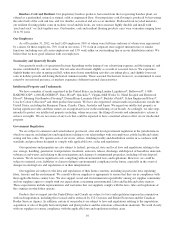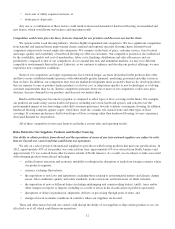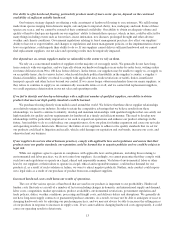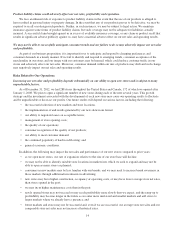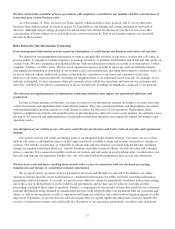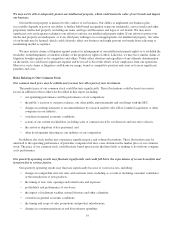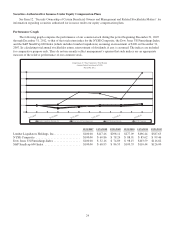Lumber Liquidators 2012 Annual Report Download - page 22
Download and view the complete annual report
Please find page 22 of the 2012 Lumber Liquidators annual report below. You can navigate through the pages in the report by either clicking on the pages listed below, or by using the keyword search tool below to find specific information within the annual report.With regard to our products, we may spend significant time and resources to ensure compliance with applicable
advertising, importation, exportation, environmental, health and safety laws and regulations. If we should violate these laws
and regulations, we could experience delays in shipments of our goods, be subject to fines or penalties, be liable for costs and
damages, or suffer reputational harm, which could reduce demand for our merchandise and hurt our business and results of
operations. Further, if such laws and regulations should change, we may experience increased costs or incur decreased
efficiency in order to adhere to the new standards.
The operation of stores in Canada may present increased risks due to our limited experience with that market.
We opened our first stores in Canada in 2011 and currently operate nine store locations there. As a result of our limited
experience in the Canadian market, these stores may be less successful than we expect. Additionally, greater investments in
advertising and promotional activity may be required to build brand awareness in that market. Furthermore, we have limited
experience with the legal and regulatory environments and market practices outside of the United States and cannot
guarantee that we will be able to operate in the Canadian market in a manner and with the results similar to our U.S. stores.
We may also incur increased costs in complying with applicable Canadian laws and regulations as they pertain to both our
products and our operations.
The operation of our Representative Office in China may present increased legal and operational risks.
In September 2011, we acquired certain assets of Sequoia Flooring Inc. (“Sequoia”) relating to Sequoia’s quality control
and assurance, product development and logistics operations in China. In connection with the transaction, we established a
representative office in Shanghai, China and assumed direct control of our product sourcing in China.
Our experience with the legal and regulatory practices and requirements in China is limited. As a result, we may incur
costs in complying with applicable Chinese laws and regulations that exceed our expectations. Further, if we fail to comply
with applicable laws and regulations, we could be subject to legal risk.
Failure to manage our growth effectively could harm our business and operating results.
Our plans call for a significant number of new stores, and increased orders from our website, call center and catalogs.
Our existing management information systems, including our store management systems and financial and management
controls, may be unable to support our expansion. Managing our growth effectively will require us to continue to enhance
these systems, procedures and controls and to hire, train and retain regional managers, store managers and store staff. We
may not respond quickly enough to the changing demands that our expansion will impose on our management, staff and
existing infrastructure. Any failure to manage our growth effectively could harm our business and operating results.
Our insurance coverage and self-insurance reserves may not cover future claims.
We maintain various insurance policies for employee health, workers’ compensation, general liability and property
damage. We are self-insured on certain health insurance plans and are responsible for losses up to a certain limit for these
respective plans. We continue to be responsible for losses up to a certain limit for general liability and property damage
insurance. In 2013, we intend to self-insure ourselves with regard to workers’ compensation coverage, in which case we will
be responsible for losses up to certain retention limits on both a per-claim and aggregate basis.
For policies under which we are responsible for losses, we record a liability that represents our estimated cost of claims
incurred and unpaid as of the balance sheet date. Our estimated liability is not discounted and is based on a number of
assumptions and factors, including historical trends, actuarial assumptions and economic conditions, and is closely monitored
and adjusted when warranted by changing circumstances. Fluctuating healthcare costs, our significant growth rate and
changes from our past experience with workers’ compensation claims could affect the accuracy of estimates based on
historical experience. Should a greater amount of claims occur compared to what was estimated or medical costs increase
beyond what was expected, our accrued liabilities might not be sufficient and we may be required to record additional
expense. Unanticipated changes may produce materially different amounts of expense than that reported under these
programs, which could adversely impact our operating results.
16


